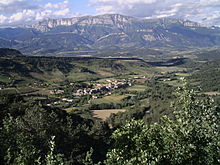Diois

The Diois is a natural landscape and historical region in what is now the French department of Drôme . It belongs to the Provencal Pre-Alps and forms the catchment area of the Drôme . Geographically, the Diois consists of the south of the Vercors massif and the north of the Diois massif. Two thirds of the Diois are part of the Vercors Regional Nature Park .
The capital of the Diois is Die at the foot of the Glandasse (2041 meters). The Communauté de communes du Diois with 52 municipalities and a good 11,000 inhabitants is also named after the Diois .
history
The Diois was inhabited by the Vocontii in antiquity , whose main towns were Luc-en-Diois for the northern and Vaison-la-Romaine for the southern Vocontii , later Dea Augusta Vocontiorum , today's Die, for the entire people. In the 10th century the landscape was under the control of the Count of Toulouse as Margrave of Provence. In 1189 the Diois was given to Aymar II of Poitier, who united it with Valentinois . The decision led to a two-century dispute with the Bishop of Die , who challenged the House of Poitiers-Valentinois for sovereignty over the area. In 1404 the Diois was given to King Charles VI. sold by France , who united it with the Dauphiné in 1426 . The later King Ludwig XI. divided the area into two Bailliages and a Sénéchaussée and thus wiped out any trace of independence in the Diois.
Important places
- Châtillon-en-Diois ,
- The
- Glandage
- Luc-en-Diois
- La Motte-Chalancon
- Pontaix
- Saillans
- Saint-Benoit-en-Diois
- Valdrôme
- Vercheny
Products
- Clairette de Die (AOC 1942)
- Crémant de Die (AOC 1993)
- Coteau de Die (AOC 1993)
- Châtillon en Diois (AOC 1975)
literature
- François Ribard, Randonnées en Diois: Du Vercors à la Drôme provençale , Glénat, coll. "Montagne - Randonnée", 2004, ISBN 2-7234-4105-9
- Dominique Duhaut, Manu Ibarra, Escalades dans le Diois , Promo grimpe, 2006, ISBN 2-914007-13-2
- Hervé Bienfait, Écoles en Diois: Témoignages de 1940 à 1970 , PUG, coll. "L'empreinte du temps", 2004, ISBN 2-7061-1245-X
- André Pitte (ed.), Le guide du Diois , éditions A. Die, 1995
- The, histoire d'une cité , éditions Patrimoine de la Vallée de la Drôme